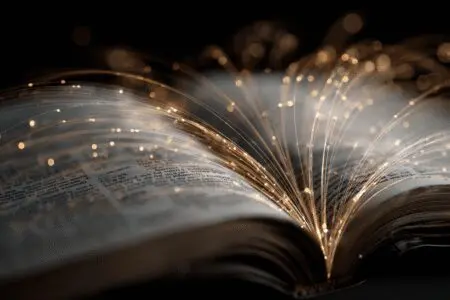I still remember the first time I decided to read the Bible on my own. I was in my early twenties, and someone had gifted me this beautiful, leather-bound King James Version. It looked important. It felt profound. I opened it to Genesis 1:1, full of inspiration, and by the time I got to the “begats,” my eyes were glazing over. The language was beautiful, sure, but it felt like a locked door. I understood the words, but I didn’t get the meaning. It was frustrating, and honestly, a little discouraging. If this was God’s Word, why couldn’t I understand it?
That experience sent me on a long journey, a quest to answer a question I was almost too embarrassed to ask: What is the easiest Bible to read? I felt like it was a secret everyone else already knew.
Turns out, it’s not a secret, and it’s one of the most important questions a Christian can ask. The whole point of the Bible is to connect with God, to understand His heart and His plan for us. If the language is a barrier, then the connection is harder to make. So, if you’re standing where I was, feeling a bit lost in the “thees” and “thous,” take heart. You’re in the right place.
More in Bible Category
What Is the Best Translation of the Bible
Which Bible Version Is the Best
Key Takeaways for Your Journey
For those who want the quick answer, here’s the rundown. But I encourage you to read on to understand why these are great choices.
- For Brand-New Readers: The New Living Translation (NLT) is often the top recommendation. It reads like a modern book, focusing on the overall meaning, which makes it incredibly accessible.
- The Best All-Around Balance: The New International Version (NIV) strikes a fantastic balance between being easy to read and staying close to the original text’s structure. It’s the most popular for a reason.
- For Devotional Reading: The Message (MSG) isn’t a direct translation but a paraphrase. It uses contemporary language and slang to bring the text to life in a fresh way. It’s perfect for a daily dose of inspiration alongside a more formal translation.
- Consider Your Goal: The “easiest” Bible really depends on your purpose. Are you reading for the first time, doing a deep study, or looking for daily encouragement? Your goal will point you to the right version.
Why Do We Even Need an “Easy” Bible Version?
It’s a fair question. If the Bible is God’s unchanging Word, why do we need so many different versions of it? Doesn’t that dilute the message? I wrestled with this for a while. It felt like choosing a “lesser” version was somehow cheating.
But then I learned a little something about how we got the Bible in the first place.
Wasn’t the Original Good Enough? A Brief Look at Translation
The books of the Bible weren’t written in English. Not even the flowery, poetic English of the King James Version. The Old Testament was written primarily in Hebrew, with a few parts in Aramaic. The New Testament was written in Koine Greek—the common, everyday language of the people at that time.
No one today speaks those languages conversationally. So, unless you’re a trained scholar, you are reading a translation. Every single English Bible is a translation.
The goal of a translation is to build a bridge from the original language and culture to our modern world. Languages change. The word “prevent” in the King James Version meant “to go before,” but today it means “to stop.” Without a modern translation, you’d misunderstand the entire meaning of that verse. An easy-to-read Bible isn’t “dumbing down” the scripture; it’s simply building a better, more modern bridge.
What Makes a Bible Translation “Easy” or “Hard” to Read?
When I first started exploring different Bibles, I ran into a bunch of confusing terms. It felt like I needed a dictionary just to understand the descriptions on the back of the box. But it really boils down to one key idea. Translators have to make a choice between two main philosophies.
Thought-for-Thought vs. Word-for-Word: What’s the Big Difference?
Imagine trying to translate the Spanish phrase “estoy en las nubes” into English.
A word-for-word translation would be “I am in the clouds.” It’s technically correct, but it doesn’t make much sense in English. We don’t say that.
A thought-for-thought translation would be “I’m daydreaming” or “My head is in the clouds.” It captures the meaning of the original phrase, not just the individual words.
Bible translations work the same way.
- Word-for-Word (Formal Equivalence): Versions like the King James Version (KJV), New American Standard Bible (NASB), and the English Standard Version (ESV) try to stick as closely as possible to the original words and sentence structure. This is fantastic for deep, scholarly study but can be very difficult for casual reading. The sentences can be long and complex.
- Thought-for-Thought (Dynamic Equivalence): Versions like the New Living Translation (NLT) and the New International Version (NIV) focus on translating the original meaning. They ask, “What was the author trying to say to the original audience, and how can we say that clearly in English today?” This makes them much, much easier to read.
There’s also a third category, the paraphrase. A paraphrase, like The Message (MSG), takes the thought-for-thought idea a step further. It’s not a translation at all but a retelling of the scriptures in very contemporary language.
There is no “right” or “wrong” approach. They are simply different tools for different jobs. For finding the easiest Bible to read, we want to look at the thought-for-thought translations.
The Top Contenders: My Experience with Easy-to-Read Bibles
Okay, let’s get into the specifics. I’ve spent years using different versions in my own life, in small groups, and in study. Here are my honest thoughts on the most popular easy-to-read Bibles.
Is the New Living Translation (NLT) the Absolute Easiest?
For my money, yes. When I finally picked up an NLT, it was like the lights came on. I remember reading through the Psalms and feeling the emotion of the writer in a way I never had before. The sentences were clear, the language was natural, and the meaning was right there on the surface. It read more like a story than a textbook.
The NLT is a thought-for-thought translation that leans heavily towards readability. The translators’ goal was to make the Bible as clear and understandable as possible for a modern reader. And they succeeded.
Who is the NLT best for?
- Someone reading the Bible for the very first time.
- Teenagers and young adults.
- Anyone who has struggled with the language of other translations.
- Readers who want a version for daily devotional reading that connects emotionally.
Of course, no translation is perfect. Some scholars feel the NLT occasionally smooths over complex ideas to make them more readable, which could cause you to miss some of the deeper nuances of the text. That’s a valid point. However, for the purpose of accessibility and understanding the main storyline of the Bible, the NLT is an absolute champion.
How Does the New International Version (NIV) Compare?
If the NLT is the easiest, the NIV is a very close second and, for many people, the better overall choice. It’s the most popular English Bible translation in the world for a good reason.
The NIV is also a thought-for-thought translation, but it tries to stay a little closer to the original text’s structure than the NLT does. I think of it as the perfect middle ground. It’s exceptionally readable but also carries a bit more of the formal weight that people expect from the Bible.
When I joined my first small group, everyone was using the NIV. It was easy to follow along, the study notes made sense, and it just worked. It’s reliable. It’s clear. It’s a workhorse of a translation that serves millions of people incredibly well.
If you find the NLT a little too informal, the NIV is probably the perfect fit for you. It strikes an incredible balance.
Can The Message (MSG) Help Me Understand the Bible Better?
This one is special, and it comes with a big asterisk. The Message is a paraphrase, not a translation. It was written by one person, Eugene Peterson, who wanted to bring the vibrant, living voice of the scriptures to his congregation.
And wow, does it ever.
Reading The Message is like having a wise old pastor sitting next to you, explaining the Bible in his own words. It uses modern idioms, powerful imagery, and a rhythm that is simply captivating. I will never forget the first time I read John 1 from The Message: “The Word became flesh and blood, and moved into the neighborhood.” That hit me so hard. Jesus moved into my neighborhood.
However, because it’s a paraphrase by one person, it’s not the best choice for your primary study Bible. It’s a commentary. An amazing one, but a commentary nonetheless. I use The Message all the time to get a fresh perspective on a passage I know well, or when a verse in the NIV or NLT isn’t quite clicking. It’s a wonderful companion to a more formal translation, but I wouldn’t recommend it as your only Bible.
How Did I Figure All This Out? My Journey Through the Versions
My search for the easiest Bible wasn’t a one-day affair. It started with that frustrating King James Version, but it continued for years. I remember going to the local Christian bookstore and just standing in the Bible aisle, completely overwhelmed. There were dozens of them. Study Bibles, devotional Bibles, Bibles for men, for women, for teens. The acronyms were a nightmare: ESV, CSB, KJV, NKJV, NASB.
I started asking people. I asked my pastor. I asked the guy who led my small group. I asked friends who I knew had been Christians a lot longer than I had. I got a lot of different answers, but a few names kept coming up: NLT and NIV.
So I went online. I used websites like Bible Gateway to read the same chapter—usually something from the Gospels, like John 3—in different translations side-by-side. That was a game-changer. I could see right away how the NLT made the story flow, and how the NIV kept a bit more of a classic feel while still being clear.
During this process, I started getting interested in why they were so different. It led me down a rabbit hole of research into translation theories. It was fascinating stuff. For anyone who wants to do a deeper dive, I found an incredibly helpful guide on this from Dallas Baptist University. It’s a bit academic, but it really clarifies the difference between the translation philosophies. You can find it here: Choosing a Bible Translation Guide from DBU.
My research taught me that this wasn’t about finding the single “best” version. It was about finding the best version for me, for the season of life I was in.
So, How Do I Choose the Right Easy-to-Read Bible for Me?
You’ve heard my story and my opinions, but now it’s your turn. How do you make the final call? You don’t want to just take my word for it. You need to find the one that speaks to your heart.
Take the Coffee Shop Test
Here’s the most practical piece of advice I can give you. Before you spend a dime, take a few versions for a test drive.
- Go to an online Bible website (like Bible Gateway or YouVersion).
- Pick a passage of Scripture you’re somewhat familiar with. I recommend Psalm 23 or John 1.
- Open up a few different translations in separate tabs: NLT, NIV, and maybe even The Message.
- Read the passage in each version.
Pay attention to how you feel.
- Which one feels the most natural to you?
- Which one makes you stop and think?
- Which one sounds like something you’d actually understand if someone were reading it aloud to you?
The version that clicks with you is the right one to start with.
What Is Your Main Goal?
Finally, ask yourself what you want to accomplish.
- If your goal is to read the Bible for the first time and understand the big picture, I wholeheartedly recommend the New Living Translation (NLT).
- If you want a great all-purpose Bible for church, small group, and personal reading, you cannot go wrong with the New International Version (NIV).
- If you are looking to supplement your reading with a fresh, dynamic voice that makes you see old truths in a new light, pick up a copy of The Message (MSG) to read alongside your main Bible.
The most important thing is to just start. Don’t let the search for the “perfect” Bible stop you from reading a Bible. The goal isn’t to become an expert on translations; it’s to get to know the author. God speaks through His Word, and He isn’t trying to hide from you in complicated language. He wants to be found. Choosing an easy-to-read Bible is simply choosing to open a door that He has already unlocked.
Frequently Asked Questions – What Is the Easiest Bible to Read

What should I know about The Message (MSG) when considering it for reading the Bible?
The Message is a paraphrase, not a translation, written to capture the feeling of the original texts in contemporary language. It is great for gaining new perspective and understanding the stories in a fresh way, but it is best used alongside more literal translations for serious study.
Is the Good News Translation (GNT) suitable for someone who finds reading difficult?
Yes, the GNT is designed with simple vocabulary and easy sentences, making it especially helpful for people who find reading challenging, including younger readers or those who speak English as a second language.
How does the New International Version (NIV) compare to the NLT for new readers?
The NIV balances modern language with accuracy, making it slightly more formal and word-focused than the NLT, but still very accessible for new readers, making it a popular choice for both daily reading and study.
What is the best Bible version for a complete beginner seeking easy reading?
For a beginner, the New Living Translation (NLT) is often recommended because it uses clear, simple language that makes the stories and teachings engaging and easy to understand, like hearing a story from a friend.
Why is choosing the right Bible translation important for easy reading?
Choosing the right translation is important because the Bible was originally written in Hebrew, Aramaic, and Greek, and various translations reflect different choices in wording and style. Some focus on a word-for-word approach, which can be harder to read but more precise, while others aim for thought-for-thought translation, making the text more accessible and easier to understand for modern readers.




